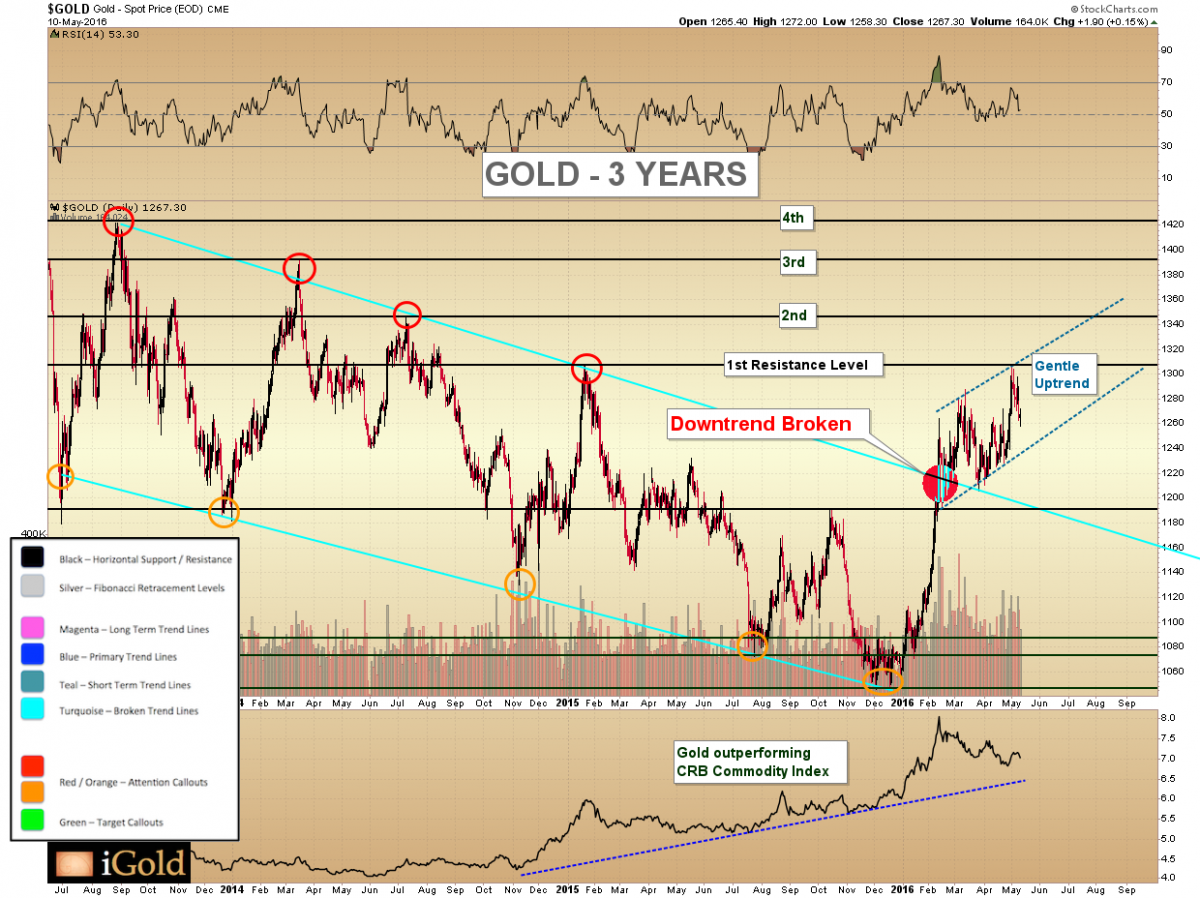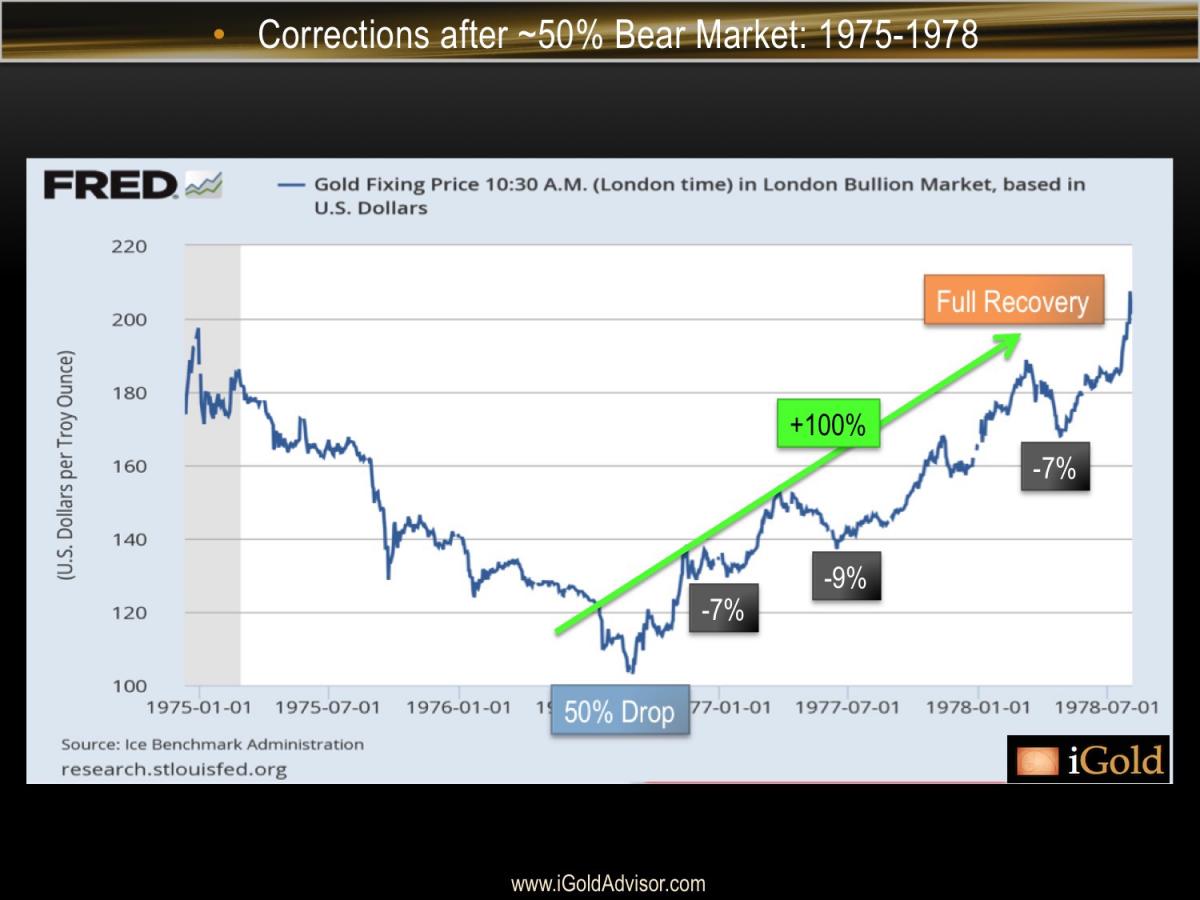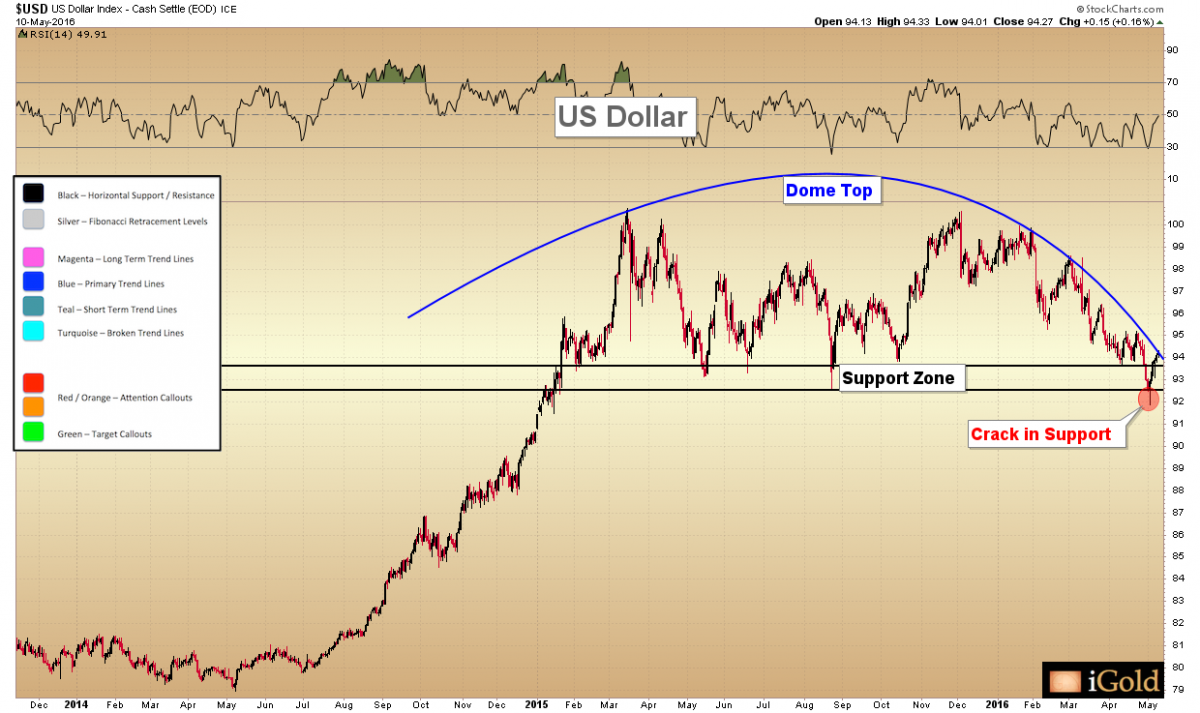Gold continues to show underlying strength despite volatility that is leaving many investors sitting on the sidelines.
Bears are frustrated that the predicted collapse in the precious metal has not yet materialized.
Bulls are expecting prices to skyrocket higher any day.
Yet a third possibility exists, and there is still time to take a middle road in one’s perceptions. Ironically, such a moderate view might just end up being the most profitable in the long run.
Indeed, the philosophy of Aristotle’s aptly-titled “Golden Mean” itself encourages us to consider the middle path, and so we begin with an examination of the gentle uptrend currently in place in the gold market.
Gold Price Continues Its Advance
Below is the 3-year chart for the spot price of gold in US Dollars.
Note the declining channel formed by a series of lower highs and lower lows that were decisively broken to the upside in February. Since then, gold has been grinding slowly higher, making a clear series of higher highs and higher lows as shown by the dashed teal-colored channel above.
The first important resistance level that exists was tested just last week, at $1,305. Such a level corresponds exactly to the January 2015 high, shown by the black horizontal line. As prices hit $1,305 and then backed off over the week, many feared a long term top was forming. However, we continue to see buying support for gold emerge in the mid $1,200’s, within our rising trend channel.
Fundamentally, we should not be surprised to see this resistance show up at $1,305. Imagine all those first-time buyers who stepped in and made purchases near this price level in January 2015. For the next 16 months, they were underwater, watching losses mount. Thus, when prices regained this important level last week, many of them decided to sell — finally getting out at even and writing gold off, perhaps altogether.
We cannot blame them. Each market participant acts in his own best interest. And if it is in one’s best interest to exit a trade at break-even, so be it.
We happen to take a longer-term perspective and know that backing and filling must occur at each of these previous horizontal resistance levels as new investors step in to buy the gold from those looking to sell at these break-even points. And so we prepare our investment strategy accordingly.
A Golden Mean Scenario
Let us discuss a “Golden Mean” scenario for the metal’s move over the next few years. It takes an equal amount of time to reach each labeled resistance level on the way higher as it did on the way lower. For example, gold took 2 years and 4 months to move down from the August 2013 high of $1,420 to the December 2015 low of $1,045. The metal is now just over 4 months out of that low at $1,270. Gold could thus take another two years to rise from $1,270 back up $1,420.
A $150 gain in two years would be nearly unfathomable to most extreme analysts, and indeed, it seems that the popular view these days is to take one of these two viewpoints: gold is either going to crash or it is going to skyrocket! Ahem — what if it does neither?
Do we have any examples of markets that made significant recoveries slowly and steadily, without anything more than a modest correction?
Indeed, all we need to do is look at gold itself in the 1970’s, in which it regained a 50% loss by doubling from $100 to $200, without so much as a 10% correction along the way.
Given that most analysts seem to fall into the extreme categories, and markets tend to fool the masses, we hereby affirm our belief that a stealth bull market is underway, one that will stop for pauses and backfill at each of our outlined resistance levels on the first chart above, before eventually surmounting them.
Former gold holders will sell at break-even at each level, causing moderate corrections, and new investors will use the opportunity to scoop up this gold. Slowly but surely, gold will climb the proverbial “Wall of Worry” of rising markets and make its way back to $1,420.
Beyond $1,420 we expect to see an acceleration in the market. Note that we are bullish on the precious metals over the long term, yet we believe it will take at least until 2020 for gold to challenge its previous all-time high near $1,900. Once a serious attempt to take out this long-term resistance is seen, we will know that the gold market is entering a new phase — what is often referred to as a “final blow-off” or “euphoria” phase, where the public en masse begins to plow significant amounts of capital into the previously-ignored precious metals.
But we are nowhere near that point yet. Please continue to do empirical data-gathering and ask your neighbors, co-workers, or coffee shop patrons whether or not they are investing in gold at present. Our analysis continues to be that this is a mostly overlooked sector, despite the recent gains we have seen. The vast majority of the potential is still ahead of us — it is simply going to take some time to materialize.
Such a period will represent an excellent opportunity for investors to continue to accumulate metal and select gold mining equities. As the worst thing for mining companies is the uncertainty of projected cash flow, a slowly rising price environment would be nearly ideal for this sector.
US Dollar Weakness – The Catalyst?
In gold, we are observing the market action that is mostly related to long-term positioning at present. News directly impacting precious metals has been light over the last two weeks. What we are witnessing is “smart money” taking early positions across the sector for macro trends which will be playing out into the future.
We cannot know for certain why high-powered money is accumulating gold — but we can surmise a clue by observing an important trend change in a major international market that has a direct impact on the precious metals.
Last week we saw an early technical failure in the US Dollar. Shown below is the US Dollar Index, a relative measure of the value of the Dollar versus the following world currencies: Euro, Japanese Yen, British Pound, Canadian Dollar, Swedish Krona, and Swiss Franc. We look at the index over a 2.5 year period:
Note that after the strong surge from July 2014 to March 2015, which coincided with significant weakness across precious metals, the Dollar has been range bound between the 93 support zone and roughly 100. Just this past week we observed a ‘crack’ in the nearly 1.5-year range in the Dollar versus these major world currencies, as the greenback traded below 92 for the first time since late 2014.
While a modest recovery was seen by the end of the week, technical cracks such as this are often the early warning indicators that a more significant breakdown is pending in the intermediate time frame. Indeed, when taken as a whole, we note that the action since 2015 is taking the formation of a Dome Top, a rounded topping pattern especially apparent since last November.
Should we see the US Dollar Index soften over the next few weeks and fall back below 92 again, it would be taken as an ominous sign that sustained dollar weakness will be ensuing. And as gold tends to move inversely to the dollar over the short run, such currency weakness is likely to be a further catalyst for the entire precious metals complex.
The anticipation of a move lower in the dollar is a likely reason for the positioning we are witnessing in the precious metals at present.
Summary
Gold has support in the mid-$1,200’s and stronger support at $1,185. We expect a slow trending move higher to be now developing. As long-term investors, this is exactly what we would hope to see at this early juncture. Measured moves higher in markets tend to be sustained, whereas explosive surges tend to fade quickly.
SOURCE: Christopher Aaron – News.Gold-Eagle.com






